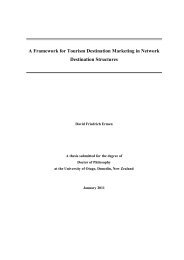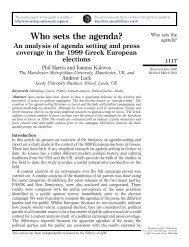Propaganda and Persuasion Book Review - Dr Phil Harris
Propaganda and Persuasion Book Review - Dr Phil Harris
Propaganda and Persuasion Book Review - Dr Phil Harris
- No tags were found...
You also want an ePaper? Increase the reach of your titles
YUMPU automatically turns print PDFs into web optimized ePapers that Google loves.
<strong>Book</strong> review‘<strong>Propag<strong>and</strong>a</strong> <strong>and</strong> <strong>Persuasion</strong>’Garth S. Jowett <strong>and</strong> Victoria O’Donnell,(Sage Publications, London, 1999; ISBN 0-7619-1146-4; 430pp; £38)The study of propag<strong>and</strong>a is an area ofresearch which has far too few comprehensiveworks of quality publishedin it. Garth Jowett <strong>and</strong> VictoriaO’Donnell <strong>and</strong> their third edition ofthe book ‘<strong>Propag<strong>and</strong>a</strong> <strong>and</strong> <strong>Persuasion</strong>’are a notable exception. It has becomealmost the st<strong>and</strong>ard text in the area <strong>and</strong>is certainly the one I would recommendto practitioners with an interestin the subject or for those who wish tostudy the topic at advanced level.The third edition has been extensivelyupdated in response to what theauthors see as the constant shift inpurpose, technology <strong>and</strong> ideology ofpropag<strong>and</strong>a. It has built in quality workfrom some of the newer studies, notablyHilmer Hoffman’s ‘The Triumphof <strong>Propag<strong>and</strong>a</strong>: Film <strong>and</strong> NationalSocialism, 1936–1945’, 1 which onecannot help but wonder whether JodieFoster has read yet as she contemplatesher own biopic on one of the greatfemale film makers of the period. It alsoincludes work covering the Gulf War 2,3<strong>and</strong> Caroline Page’s ‘Official <strong>Propag<strong>and</strong>a</strong>during the Vietnam War, 1965–1973: The limits of persuasion’, 4 <strong>and</strong>was strengthened by the publication<strong>and</strong> ideas of the laudable ‘Munitions ofthe Mind: War propag<strong>and</strong>a from theancient world to the nuclear age’ by<strong>Phil</strong>ip Taylor. 5The case studies have been strengthened<strong>and</strong> developed to take account ofmodern developments <strong>and</strong> advancedstudent need. They reflect a diverse <strong>and</strong>important set of areas of potentialstudy: women <strong>and</strong> the war (WW2);the Gulf War; smoking <strong>and</strong> health <strong>and</strong>Premarin: a bitter pill to swallow. Theauthors thus show the operation of thestate propag<strong>and</strong>a machine in two wars<strong>and</strong> the use of propag<strong>and</strong>a aroundhealth <strong>and</strong> the tobacco industry <strong>and</strong> itsuse in the pharmaceutical business.The text is set out logically <strong>and</strong> interspersedwith good-quality illustrations,although one must wonder whetherSage cannot upgrade to colour for theinevitable fourth edition, as such postersas Bird’s ‘Careless Talk Costs Lives’<strong>and</strong> El Lissitzky’s famous propag<strong>and</strong>aposter ‘Beat the Whites with the RedWedge’ certainly lose something inblack <strong>and</strong> white. With recent exhibitionson the evolution of the iconographicposter in the Soviet bloc <strong>and</strong>the rise of cause advertising, this isclearly an area of potential for brighteningup the text.The structure of the book is a goodone. The first chapter offers definitionsof the area <strong>and</strong> outlines how themodern study of propag<strong>and</strong>a cameabout after the First World War <strong>and</strong>led the way to the social scientific studyof persuasion. As Doob points out, 6propag<strong>and</strong>a as a word became less used<strong>and</strong> was replaced by such words ascommunication, information <strong>and</strong> persuasionbecause they imply no valuejudgment <strong>and</strong> tend to embrace thedevelopment of new communicationtechnologies as well as the intricate per-Page 5
<strong>Book</strong> reviewplexities inherent in developing societies<strong>and</strong> international diplomacy. Chapters2, 3 <strong>and</strong> 4 review the theories <strong>and</strong>research regarding persuasion <strong>and</strong> propag<strong>and</strong>a.Chapter 5 examines the use ofpropag<strong>and</strong>a in psychological warfare;then come the emerging fear of propag<strong>and</strong>amethods of analysis (Chapter 6),the four case studies (Chapter 7) <strong>and</strong>the process model that depicts howpropag<strong>and</strong>a works in modern society(Chapter 8). It is extensively referenced<strong>and</strong> draws upon both North American<strong>and</strong> European literatures, which is bothpleasing to see <strong>and</strong> adds to its comprehensivenessas a text.Where this text is so good is in itsappreciation of propag<strong>and</strong>a throughouthistory <strong>and</strong> society. For instance, asGoebbels described Hitler’s propag<strong>and</strong>aprinciples, which he had extracted from‘Mein Kampf’:‘A carefully built up erection of statements,which whether true or false canbe made to undermine quite rigidly heldideas <strong>and</strong> to construct new ones that willtake their place. It would not be impossibleto prove with sufficient repetition<strong>and</strong> psychological underst<strong>and</strong>ing of thepeople concerned that a square is in facta circle. What after all are a square <strong>and</strong> acircle? They are mere words <strong>and</strong> wordscan be molded until they clothe ideas indisguise.’ 6This gives insight both into the reality<strong>and</strong> evil of how propag<strong>and</strong>a can beused as a powerful communicationtool.The text allows the specialist <strong>and</strong> studentto assess the impact of propag<strong>and</strong>a<strong>and</strong> its place as part of modern communications.The final chapter presentsa model of propag<strong>and</strong>a <strong>and</strong> several premisesthat have evolved from theevents, ideas <strong>and</strong> concepts discussed inearlier chapters. The book is a musthave for anybody interested in modernmarketing communications work toput it in context <strong>and</strong> to learn from thepast.<strong>Dr</strong> <strong>Phil</strong> <strong>Harris</strong>Centre for Corporate <strong>and</strong>Public AffairsManchesteer MetropolitanUniversity Business SchoolREFERENCES1. Hoffman, H. (1996) ‘The Triumph of<strong>Propag<strong>and</strong>a</strong>: Film <strong>and</strong> National Socialism,1936–1945’, Berghahn, Providence,RI.2. Kellner, D. (1992) ‘The Persian GulfTV War’, Westview, Boulder, CO.3. Taylor, P. M. (1992) ‘War <strong>and</strong> theMedia: <strong>Propag<strong>and</strong>a</strong> <strong>and</strong> persuasion inthe Gulf War’, Manchester UniversityPress, Manchester, UK.4. Page, C. (1996) ‘US Official <strong>Propag<strong>and</strong>a</strong>during the Vietnam War,1965–1973: The limits of persuasion’,Leicester University Press, London.5. Taylor, P. M. (1990) ‘Munitions ofthe Mind: War propag<strong>and</strong>a from theancient world to the nuclear age’,Patrick Stephens, Wellingborough,UK.6. Doob, L. W. (1966) ‘Public Opinion<strong>and</strong> <strong>Propag<strong>and</strong>a</strong>’, 2nd edn, Archon,H<strong>and</strong>en, CT.7. Thomson, O. (1977) ‘Mass <strong>Persuasion</strong>in History’, Paul <strong>Harris</strong>, Edinburgh.Page 6




